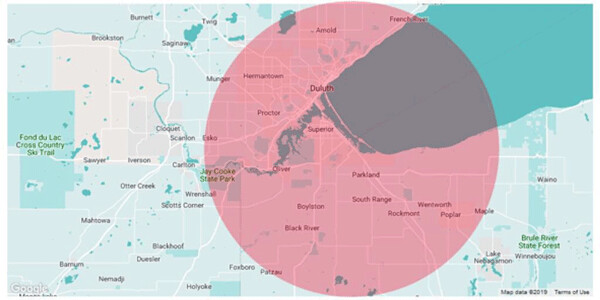Welcome to the Kill Zone- the Shadow of Husky
“In four years, three major accidents have occurred that could have led to large hydrogen fluoride releases. This exposes a shocking level of disregard for public safety. Oil companies are passing along large accident-related costs to consumers while pleading poverty when asked to replace hydrogen fluoride with processes that use safer chemicals.” — Daniel Horowitz, former managing director of the U.S. Chemical Safety Board, July 8th, 2019
At the end of the fossil fuel era, stuff crumbles and the wear and tear of 70 years on infrastructure begins to show. Sometimes things blow up. On April 26, 2018 the Fluid Catalytic Cracking Unit in the Husky Refinery in Superior, Wisconsin, exploded, sending fireballs and a plume of black smoke into the sky. The residents of Duluth and Superior were pretty lucky, because the explosion didn’t rupture the refinery’s hydrogen fluoride (HF) tank that was just 150 feet from the explosion[1]. As luck would have it, a piece of shrapnel from the explosion ruptured a more distant asphalt tank that then caught fire.[2] According to the Star Tribune, a rupture of the HF tank would have created a “dense cold killing cloud” and put l80,000 people at risk.
HF is lethal when inhaled, and on contact causes severe burns, fluid buildup in the lungs, swelling of lung tissue, and more nasty stuff. A potential HF release at the Husky Refinery is why Superior citizens were evacuated in April 2018. Just like any burn, there is no “cure” for exposure to HF because affected flesh is simply destroyed. If you are too close when a HF tank ruptures and you breath in too much HF, you’re dead.
Welcome to the Kill Zone
[1] Letter, Members of Minnesota Congressional Delegation to United States Chemical Safety and Hazard Investigation Board, Sept. 2, 2018. [1] Letter, United States Chemical Safety and Hazard Investigation Board to U.S. Environmental Protection Agency, Apr. 23, 2019.
“The Kill Zone is a term coined by a California Legislator in response to use of HF inside of the middle of a city. The Kill Zone is the area where citizens would not have time to evacuate in under 10 minutes, which is the time it would take for a full tank of HF to be released into surrounding neighborhoods. But, an HF rupture could impact a much larger area. Here’s the scenario: 39,540 pounds of HF vaporized over 10 minutes.

Maximum Area Threatened: 22-mile radius ·
Maximum Residential Population Threatened: 180,000
This larger area is called the Vulnerability Zone and it extends 11 miles from the refinery. This is the area around the refinery where a ground-hugging vapor cloud of HF could travel, impacting everything that lives in the path. For those who live in the Twin Ports, here’s an opportunity to check out your house here: www.epa.gov/rmp/forms/vulnerable-zone-indicator-system-option-2 The Worst- Case scenario comes from the Risk Management Plan created by the refinery and submitted to the EPA for compliance with EPCRA. It’s pretty clear that there’s some risk, big time. If you’re a local, you are not alone. A joint investigation by the Center for Public Integrity and ABC News found at least 16 million Americans, many of them unaware of the threat, live in the potential path of HF if it were to be released in an accident or a terrorist attack. The government maintains closely controlled nonpublic reports outlining worst-case scenarios involving highly hazardous chemicals. The Center reviewed reports for the 50 refineries that use HF. The reports describe the most extreme accidents anticipated by the plants’ owners. It’s not pretty. https://publicintegrity.org/workers-rights/use-of-toxic-acid-puts-millions-at-risk/ Nationally and internationally workers are, for good reason, concerned about the use of hydrogen fluoride, especially since there are alternatives. It’s just that those alternatives are expensive, and many companies prefer to continue with the risk. The United Steelworkers Union, one of the largest unions which represent refinery workers, has strongly opposed the use of HF at oil facilities due to the severe risks it poses to workers at refineries and citizens in nearby communities.
Mitigation Failures
There are some plans, but they are pretty iffy. After the 2018 explosion, Husky identified three additional mitigation measures:1) increase the amount of water that would be sprayed on the HF tank in the event of a rupture,2) install a pump to transfer the HF to a different tank in an emergency, and install a laser detection system. These are pretty hopeful, and we should all cross our fingers. Unfortunately, the potential for mitigation failure was why the evacuation was ordered in Superior. Safety systems, such as water sprays, chemical additives and emergency inventory dump systems, are intended to try to contain a hydrogen fluoride release, but none of these methods have been shown to be completely reliable. For example, in 2008, the Occupational Safety and Health Administration cited the refinery, then owned by Murphy Oil, for intentionally disabling the HF alarm system when the facility was owned by Murphy Oil. Just because mitigation systems are in place doesn’t mean they will work.
What’s the Solution?
Husky says that it has no choice but to keep using HF at its 38,000 bpd refinery, because alternatives are not available. Yet, Chevron’s 55,000 bpd Salt Lake Refinery is in the process of installing a new technology developed by Minnesota based Honeywell called Ionic Liquids Alkylation Technology (ISOALKY) that safely replaces HF. The Salt Lake Refinery primarily processes US western crude oils, but also refines medium and heavy crude oil from Canada, as does the Superior Refinery. Honeywell successfully operated an ISOALKY demonstration plant for five years, and based on this demonstration Chevron decided three years ago to replace its HF unit. According to Chevron, ISOALKY can utilize the same feed stock and the new unit can be installed while the HF unit is in operation, resulting in minimal disruption to refinery operations.
On its website, all Husky will say is that ISOALKY “is an unproven, emerging technology and not currently suited for use at the Superior Refinery.” Husky's chief operating officer said being the first to implement the technology was not something it was "enthusiastic" about with the risks involved in trying newer systems. [B1] From the reviews of their materials, it sounds like Husky thinks ISOALKY could work, but doesn’t want to take the commercial risk. Based on the risk of the hydrogen fluoride explosion, Superior’s mayor and, indeed Duluth, might want to request more of the company.
In other words, rather than trust Husky’s self-serving judgment about ISOALKY, Husky could be required to request a technical feasibility analysis and a cost estimate from Honeywell, so that we all know its technical potential and cost.
Husky shouldn’t be let off the hook, just because it’s too cheap and backward to try a new better technology.
If Husky refuses to provide an objective evaluation of the ISOALKY alternative, the Duluth-Superior region might consider whether the risks and pollution of the Superior Refinery are worth its small output and economic contribution to the region. On average, the refinery processes just 38,000 barrels of crude oil per calendar day, making it one of the smallest refineries in the nation. Given that the total refining capacity in the Midwest is 4,377,000 bpd, the Superior Refinery represents less than 1% of regional refining capacity. If the refinery disappeared, fuel and asphalt would be shipped to Duluth-Superior, and the impact would likely be negligible.
The Twin Ports could be safer and cleaner, not a bad idea, really. Aside from that, technology is changing rapidly, and electric vehicles are increasing in numbers and popularity- Google just ordered l0,000 of them, as did Amazon.
Electric cars will soon be more affordable than gas and diesel vehicles, and fewer oil refineries will be needed anyway. Times change. Here’s an example: This year, Exxon/Mobil dropped out of the top ten of the S and P 500, for the first time in nine decades. In l982, the 400 richest people in the world included 89 who made their money from oil, today the top 59 is dominated by technology tycoons. Six of the ten richest people in the world are tech heads.
How’s that translate- these firms are changing the future of energy i.e.: the defacto prohibition on renewable energy is ending.
Amazon announced it will be carbon neutral in 2040, with 80% of its power coming from renewables by 2024. They just announced a buy of l0,000 electric vehicles, Google is following suit, along with Daimler Engines, (they basically brought us the gasoline engine) which has announced it will move entirely to electric engine work.
Toyota has just brought the Toyota Mirai , a fully hydrogen powered vehicle on line- that’s zero emissions. Rose Marcario, Patagonia CEO points tweets out, “The plain truth is that capitalism needs to evolve if humanity is to survive.
“ Times change, and so should Husky.
Just Transition
“We need to stop using the specter of economic decline and loss of energy-sector jobs as a reason for inaction. These are excuses that no longer wash with energy workers or the public. While thankful for all that the fossil-fuel industry has given Canada over the years, we all see the writing on the wall. It’s time to change and energy workers are ready to help,” writes Lliam Hildebrand executive director of Canadian-based Iron & Earth, comprised of many energy sector workers. “An important aspect of the transition away from fossil fuels is that our nation’s energy-sector workers are ideally positioned to help build a vibrant and globally competitive clean-energy sector.
This is because fossil-fuel infrastructure has a similar industrial “DNA” to sustainable-energy infrastructures, such as biofuels, biomass, geothermal, hydrogen and many other large-scale steel infrastructure projects. Thus, these projects require many of the same skill sets, the kind of attributes found in abundance in our oil and gas workforce.” Indeed, a 2016 survey by Iron & Earth of skilled trades workers primarily with experience in the energy industry showed that 63 per cent believed their current skill set could be transferred to build and maintain a renewable energy future with some training, and 86 per cent expressed interest in training and development in renewables. Superior deserves better.
And, frankly, the medical establishment of the Twin Ports, as well as schools and churches should urge a transition by the company. The time to be safe is now. [1] Letter, Members of Minnesota Congressional Delegation to United States Chemical Safety and Hazard Investigation Board, Sept. 2, 2018. [2] Letter, United States Chemical Safety and Hazard Investigation Board to U.S. Environmental Protection Agency, Apr. 23, 2019. [B1]What may be going on here is that the Superior Refinery is actually very small, when one considers that 40% of its capacity is in the form of asphalt and road oil production (bitumen), rather than more refined products.
Given that the Superior Refinery’s total nominal (calendar day) capacity is 38,000 bpd, this means that it produces just 22,000 bpd of fuels, which relatively speaking is a tiny amount. The Salt Lake Refinery has an alkylate production capacity of 5,600 bpd, whereas the Husky refinery’s capacity is just 1,700 bpd. In comparison, Koch’s Flint Hills refinery has a capacity of 320,000 bpd and an alkylate capacity of 12,500 bpd. The Superior Refinery is a very simple, small refinery so Husky probably doesn’t want to invest much in it.
